🎗️Lonny's War Update- October 455, 2023 - January 3, 2025 🎗️
🎗️Day 455 that 100 of our hostages in Hamas captivity
**There is nothing more important than getting them home! NOTHING!**
“I’ve never met them,But I miss them. I’ve never met them,but I think of them every second. I’ve never met them,but they are my family. BRING THEM HOME NOW!!!”We’re waiting for you, all of you.
A deal is the only way to bring
all the hostages home- the murdered for burial and the living for rehabilitation.
#BringThemHomeNow #TurnTheHorrorIntoHope
A deal is the only way to bring
all the hostages home- the murdered for burial and the living for rehabilitation.
#BringThemHomeNow #TurnTheHorrorIntoHope
There is no victory until all of the hostages are home!אין נצחון עד שכל החטופים בבית
Red Alerts - Missile, Rocket, Drone (UAV - unmanned aerial vehicles), and Terror Attacks and Death Announcements
*4:30am- Jerusalem and country center- ballistic missile from Yemen - intercepted
IDF says it downed drone from Yemen, hours after ballistic missile interception
A drone launched at Israel from Yemen a short while ago was successfully intercepted by the Israeli Air Force, the military says.
According to the IDF, the drone was shot down outside of Israel’s borders, and therefore no sirens sounded.
The drone attack comes hours after the Houthis in Yemen launched a ballistic missile at Israel, which the IDF said was also intercepted, although fragments fell in the Modiin area.*12:10pm - south - Gaza Envelop- rockets - Kibbutz Be'eri
One rocket was launched from the central Gaza Strip at the southern border community of Be’eri a short while ago, the military says.
The IDF says it launched an interceptor missile at the rocket, but the results of the interception attempt are still under investigation.
There are no injuries in the attack.
It marks the first time in over 10 months that sirens have sounded in Be’eri due to rocket fire from Gaza.
It also marks the eighth day in a row of rocket fire from Gaza, with at least 16 rockets fired during that time.
The IDF says it launched an interceptor missile at the rocket, but the results of the interception attempt are still under investigation.
There are no injuries in the attack.
It marks the first time in over 10 months that sirens have sounded in Be’eri due to rocket fire from Gaza.
It also marks the eighth day in a row of rocket fire from Gaza, with at least 16 rockets fired during that time.
One rocket was launched from the central Gaza Strip at the southern border community of Be’eri a short while ago, the military says.
According to the military, one of the rockets impacted near Kibbutz Nir Am, while another hit an open area.
There are no injuries in the attack.
Meanwhile, military sources say that the sirens earlier today in Be’eri were triggered by a surface-to-air missile launched at an Israeli Air Force helicopter over Gaza.
The shoulder-launched missile was fired by a terror operative in the Bureij area of central Gaza.
IDF sources say that the missile did not come close to hitting the helicopter, and it was successfully shot down by the Iron Dome air defense system.
Sirens had sounded in Be’eri because of the trajectory of the anti-aircraft missile.
Hostage Updates
Hostage Updates
- Israeli delegation departs for hostage deal talks in Qatar
Channel 12 reports that a delegation of “working-level” negotiators have departed Israel to attend talks in Qatar on a hostage-ceasefire deal in the Gaza Strip, after Prime Minister Benjamin Netanyahu said yesterday that he had okayed the delegation’s departure.
A delegation from the Hamas terror group is also expected in Doha to continue the negotiations, amid reports in recent days that the talks had reached an impasse. link Working level negotiators is always a good sign. These are the people who work out the fine details of an agreement and prepare it for top negotiators and decision makers for the fine tuning, if it can reach that stage and Netanyahu doesn't throw in any more last minute demands that can destroy a deal.
- Hostage families hail decision to send negotiating team to Qatar: ‘We can’t miss this window of opportunity’
Channel 12 reports that a delegation of “working-level” negotiators have departed Israel to attend talks in Qatar on a hostage-ceasefire deal in the Gaza Strip, after Prime Minister Benjamin Netanyahu said yesterday that he had okayed the delegation’s departure.
A delegation from the Hamas terror group is also expected in Doha to continue the negotiations, amid reports in recent days that the talks had reached an impasse. link Working level negotiators is always a good sign. These are the people who work out the fine details of an agreement and prepare it for top negotiators and decision makers for the fine tuning, if it can reach that stage and Netanyahu doesn't throw in any more last minute demands that can destroy a deal.
Israeli rally for the release of hostages held by Hamas, at Tel Aviv's Hostage Square, December 21 2024. (Avshalom Sassoni/Flash90)
The Hostages and Missing Families Forum hails a decision by Prime Minister Benjamin Netanyahu to send a new negotiating team to hostage talks in Qatar, saying “We can’t miss this window of opportunity.”
“The 100 hostages held in the depths of the Hamas tunnels don’t have time for foot-dragging in the negotiations, we demand that the prime minister give the negotiating team a mandate to reach an agreement that will see the return of every last hostage — the living to rehabilitation and the murdered for an honorable burial,” the forum says.
The Messages from the Defense Minister, the Hostage Coordinator, and the Delegation Heading to Qatar
Israeli officials are conveying messages that negotiations for a deal are ongoing. Hostage Coordinator Gal Hirsch, in conversations with families of hostages, stated, "There is slow but consistent progress—and also challenges." Minister Israel Katz echoed a similar sentiment: "The deal is not stuck." Meanwhile, the Prime Minister's Office confirmed that a high-level delegation will travel to Qatar, while families stress: "The hostages have no time."
Behind the scenes, frantic efforts are underway by mediators, alongside the U.S., to finalize a deal for the release of hostages before Trump's inauguration on January 20. Tomorrow (Friday), as confirmed by Prime Minister Netanyahu in an official statement, a senior Israeli delegation is expected to depart for Qatar to tie up loose ends and attempt a breakthrough.
Progress Amid Challenges
Messages indicating continued progress were highlighted in a conversation between Hostage Coordinator Gal Hirsch and families of the missing. "The talk of a deadlock is incorrect," Hirsch said. "Negotiations are ongoing under heavy secrecy. Efforts are being made to reach a point acceptable to Hamas, and agreements on many details have already been reached. There is slow and consistent progress—but also difficulties."Minister Katz: The Deal Is Not Stuck but Progressing Slowly
Defense Minister Israel Katz addressed the negotiations in a conversation with the families of hostages earlier this week. In response to their concerns over reports of stalled negotiations, Katz reassured them, emphasizing progress.- Minister Katz: "Do not pay attention to background noise. Progress is being made in the negotiations quietly."
- A parent: "But they keep saying the deal is stuck."
- Minister Katz: "True, but behind the scenes, there is progress. The deal is not stuck, just slower."
- A parent: "But Hamas hasn’t submitted lists."
- Minister Katz: "That’s part of the disagreement. But we are doing everything to resolve it."
- A parent: "And what about a comprehensive deal for all the hostages—will it only happen if Israel agrees to their demands?"
- Minister Katz: "I don’t want to get into those details. The Prime Minister and the professional teams need to be allowed to manage the negotiations."
Trump’s Message to the Family of an American Hostage
After it was revealed that kidnapped soldier Omar Naotra was murdered on October 7 and his body is being held in Gaza, incoming U.S. President Donald Trump spoke with his family, who are American citizens, during their mourning period in early December. Trump conveyed a message that they are doing and will continue to do everything possible to secure the release of their son and the other hostages.President-elect Trump expressed his condolences to the family, stating that this should never have happened. He praised Adam Boehler, whom he appointed as his administration’s head of hostage affairs, describing him as "the right person for the mission." Trump assured them that he and his team are committed to this issue and believes they will do a good job.
"The Hostages Have No Time"
The Hostage Families Headquarters on the delegation’s trip: "We must not miss the window of opportunity. The hostages held deep in Hamas tunnels in Gaza have no time for dragging feet in the negotiations. We demand Netanyahu grant the team full authority to achieve an agreement ensuring the return of all hostages—every last one of them: the living for rehabilitation and the murdered for burial."Forum Tikva, a coalition of hostage families, stated following the announcement of the delegation’s departure: "While we chase after Hamas and Qatar, their terror-financing partner, the release of the hostages drifts further away. This behavior portrays us as weak, and the enemy exploits it for further manipulation and abuse. Only continued pressure, exemplified by complete occupation of northern Gaza, along with a firm demand that no Palestinian returns to the area until all hostages are released, will compel Hamas to free everyone."
They added, "Hamas fears nothing more than losing control of northern Gaza. We must listen to them, understand their fears, and strike at their most vulnerable point." link It's hard for the families to believe anything that these two are saying. Not only have they not gained the trust of the families, they haven't done anything to earn that trust, they are both yes men of Netanyahu's and message what Netanyahu wants them to message. And Netanyahu's track record of speaking truth to the hostage families is entirely wanting. And if we look at statements that Katz has made to the press, they are exactly mimicking Netanhayu's statements and causing damage to the negotiations because those statements are all damaging to any deal that could be worked out. It does appear that Netanyahu is more willing to make a deal but only a partial deal and absolutely not end the war. It is very doubtful that Hamas will agree to even a partial deal, knowing that the army will return to fighting immediately after that first part ends, as Netanyahu has stated multiple times. And Hamas won't make any deal that doesn't entail ending the war, not a ceasefire but an end.
Gaza and the South
Following rocket fire from the central Gaza Strip at the southern border community of Be’eri, the IDF has issued an evacuation warning for Palestinian civilians in the Bureij area.
“Terror organizations are once again firing rockets from this area that has received warnings several times in the past,” Col. Avichay Adraee, the IDF’s Arabic-language spokesman says on X, attaching a map of the areas that are to be evacuated.
Civilians are urged to head for the Israeli-designated humanitarian zone in southern Gaza before the IDF launches strikes on the area.
- IDF says some 40 Hamas command centers, terror staging grounds struck in Gaza over past day
Over the past day, the IDF says it launched airstrikes against some 40 staging grounds for terror operatives and Hamas command centers across the Gaza Strip.
The strikes were launched by the Israeli Air Force in a joint operation with the IDF Southern Command, following intelligence provided by the Military Intelligence Directorate and Shin Bet security agency.
The IDF says dozens of Hamas operatives were gathered at the targeted sites, from where they planned and launched attacks against troops in Gaza and against Israel.
Some of the sites were embedded in former schools, which have also served as shelters for displaced Palestinians. The IDF says this is “another example of Hamas’s cynical and systematic use of civilians and civilian infrastructure in the Gaza Strip for terror purposes.”
The military says it took steps to mitigate civilian harm in the strikes, including by using “precision munitions, aerial surveillance, and other intelligence.”
UNRWA said preparing to shutter Gaza, West Bank offices after Israel votes to limit its operations
- Military says Nahal Brigade troops destroyed Hamas tunnels, weapons during Beit Hanoun operation
Troops of the IDF’s Nahal Brigade destroyed several Hamas tunnels and weapons during operations this past week in northern Gaza’s Beit Hanoun, the military says.
The IDF launched a fresh operation in Beit Hanoun last weekend.
The military says that the Nahal troops, operating under the Gaza Division, killed several cells of gunmen, and demolished infrastructure used by terror groups, including tunnels.
The troops also located numerous weapons, including rocket launchers, mortars, RPGs, and explosive devices, along with other equipment, the IDF says.
The brigade has also directed several airstrikes in Beit Hanoun, the IDF says, including a drone strike on a rocket launcher used by terrorists in a previous attack on Israel.
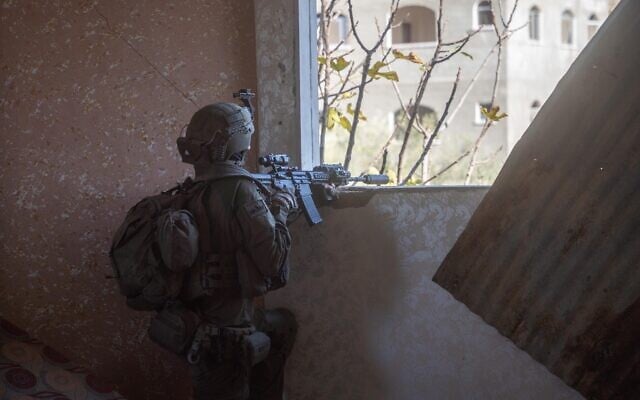 Troops of the Nahal Brigade operate in northern Gaza’s Beit Hanoun, in a handout photo issued by the IDF on January 3, 2025. (Israel Defense Forces)
Troops of the Nahal Brigade operate in northern Gaza’s Beit Hanoun, in a handout photo issued by the IDF on January 3, 2025. (Israel Defense Forces) - Hamas-run health ministry says 77 Gazans killed in last 24 hours
Gaza’s Hamas-run health ministry says 77 people were killed in the coastal enclave in the past 24 hours, bringing the overall death toll of the war to 45,658.
The ministry also says in a statement that at least 108,583 people had been wounded in nearly 15 months of war between Israel and Hamas triggered by the Palestinian terror group’s October 7 onslaught in which some 1,200 Israelis were killed and roughly 250 were taken hostage.
Israel has intensified airstrikes over the past day following renewed rocket fire at southern Israel. Israel insists it doesn’t target civilians, while Hamas hides and fights among them.
The IDF releases drone footage from a former school in northern Gaza’s Jabalia, where Hamas operatives had been previously holed up.
The drone video shows several assault rifles inside the damaged school building.
The IDF says the school was searched by troops of the Givati Brigade, who found numerous weapons. In a nearby residential building, the military says the troops found RPGs in a child’s bedroom.
Also during the operations in Jabalia, the IDF says the Givati troops, using a drone, spotted terror operatives planting bombs close to where they were operating. The operatives were eliminated and the explosive device was destroyed, the military adds. drone video of weapons discovered in school
COGAT, the Defense Ministry body responsible for overseeing the delivery of humanitarian aid to Gaza, says that 1,200 units of blood were delivered to Nasser Hospital in Khan Younis via the Kerem Shalom Crossing yesterday.
It says that the blood, along with 3,000 units of plasma, was delivered “to support ongoing treatments and maintain essential operations at the hospital.”
The operation was carried out in coordination with international organizations, COGAT states, and the transfer underwent “stringent security inspections.”
“The IDF, through COGAT, will continue to act in accordance with international law to provide humanitarian assistance to the residents of the Gaza Strip, especially as it pertains to medical care,” it adds.
Northern Israel - Lebanon/Hizbollah/Syria
German Foreign Minister Annalena Baerbock is traveling to Syria for a one-day trip with her French counterpart on behalf of the EU. While there, she will meet with the leader of Syria’s new ruler, Ahmed al-Sharaa, the German foreign ministry says on Friday.
“My trip today — together with my French counterpart and on behalf of the EU — is a clear signal to the Syrians: A new political beginning between Europe and Syria, between Germany and Syria, is possible,” Baerbock says, according to a ministry statement issued before she departs for Damascus.
She adds that she is traveling to Syria with an “outstretched hand” after rebels seized control of Damascus on December 8, forcing Syria’s president Bashar al-Assad to flee after more than 13 years of civil war and ending his family’s decades-long rule.
“We now have a goal in mind that millions of Syrians also long for: That Syria can once again become a respected member of the international community,” she adds. link The world is paving the wave for a new Syria, yet Israel, not only remains on the sidelines but is even antagonistic towards the new leadership whereas we should be making concrete steps to open a dialogue with them and perhaps change the face of this neck of the woods.
Syrian media report an Israeli airstrike near Aleppo a short while ago.
According to the Sham FM radio station, the strikes hit a defense facility and a scientific research center near the city of al-Safirah, close to Aleppo.
There is no immediate comment from the IDF.
Syria has imposed new restrictions on the entry of Lebanese citizens following skirmishes between Lebanon’s army and Syrian fighters, a military official and two security sources from Lebanon tell AFP.
A General Security official tells AFP they were “surprised to see the border had been closed” to Lebanese citizens “from the Syrian side,” with another security source saying “It seems they [Syria] have new procedures,” allowing in only Lebanese with residency permits or official permission.
The military official says the move followed “skirmishes between the Lebanese army and Syrian fighters at the border.” link This could be a sign of the declaration by the new Syrian leadership that they will not allow Syria to be a launching area for fights with its neighbors, another possible good indication that the new Syrian leadership is looking for peaceful relations with all of its neighbors including Israel
Take Me to Al-Joulani: Syria's Leader Attracts Many Suitors, All with Their Own Interests
Between Russia and the West, between the Kurds and the Turks, amid complex reconstruction challenges and with Qatar also extending its influence, Damascus’s future hinges on the decisions Ahmad Al-Sharaa will make in the coming months—decisions of great consequence.
German Foreign Minister Annalena Baerbock is traveling to Syria for a one-day trip with her French counterpart on behalf of the EU. While there, she will meet with the leader of Syria’s new ruler, Ahmed al-Sharaa, the German foreign ministry says on Friday.
“My trip today — together with my French counterpart and on behalf of the EU — is a clear signal to the Syrians: A new political beginning between Europe and Syria, between Germany and Syria, is possible,” Baerbock says, according to a ministry statement issued before she departs for Damascus.
She adds that she is traveling to Syria with an “outstretched hand” after rebels seized control of Damascus on December 8, forcing Syria’s president Bashar al-Assad to flee after more than 13 years of civil war and ending his family’s decades-long rule.
“We now have a goal in mind that millions of Syrians also long for: That Syria can once again become a respected member of the international community,” she adds. link The world is paving the wave for a new Syria, yet Israel, not only remains on the sidelines but is even antagonistic towards the new leadership whereas we should be making concrete steps to open a dialogue with them and perhaps change the face of this neck of the woods.
Syrian media report an Israeli airstrike near Aleppo a short while ago.
According to the Sham FM radio station, the strikes hit a defense facility and a scientific research center near the city of al-Safirah, close to Aleppo.
There is no immediate comment from the IDF.
Syria has imposed new restrictions on the entry of Lebanese citizens following skirmishes between Lebanon’s army and Syrian fighters, a military official and two security sources from Lebanon tell AFP.
A General Security official tells AFP they were “surprised to see the border had been closed” to Lebanese citizens “from the Syrian side,” with another security source saying “It seems they [Syria] have new procedures,” allowing in only Lebanese with residency permits or official permission.
The military official says the move followed “skirmishes between the Lebanese army and Syrian fighters at the border.” link This could be a sign of the declaration by the new Syrian leadership that they will not allow Syria to be a launching area for fights with its neighbors, another possible good indication that the new Syrian leadership is looking for peaceful relations with all of its neighbors including Israel
Take Me to Al-Joulani: Syria's Leader Attracts Many Suitors, All with Their Own Interests
Between Russia and the West, between the Kurds and the Turks, amid complex reconstruction challenges and with Qatar also extending its influence, Damascus’s future hinges on the decisions Ahmad Al-Sharaa will make in the coming months—decisions of great consequence.
Nearly a month has passed since Bashar al-Assad’s hasty escape, and Syria’s new leadership, grappling with numerous internal and external challenges, is preparing for the "National Dialogue Conference." During this event, they hope to form a new government, draft a constitution, and unify Syrian society under one banner.
The opposition to Assad was known to include a variety of groups, among them Islamic jihadist organizations. Ahmad Al-Sharaa, formerly known as Al-Joulani, leader of Hay'at Tahrir al-Sham, understands that if he seeks legitimacy for his rule in the West, he must project a clean image. However, his past with Al-Qaeda continues to overshadow his promises for a more peaceful future.
Countries worldwide are involved in Syria’s unfolding story, and the pilgrimage to Damascus shows no signs of slowing. Ukraine, Kuwait, Qatar, Turkey, and the United States are just some of the nations sending delegations to meet with the new Syrian leadership. Today (Friday), German Foreign Minister Annalena Baerbock and French Foreign Minister Jean-Noël Barrot visited Damascus, including the Saydnaya Prison. Barrot even announced that France’s diplomatic mission would soon return to Syria.
Russia's Role
Russia, which alongside Iran propped up Assad’s regime for years and bears responsibility for hundreds of thousands of Syrian deaths, is also courting the new government. Meanwhile, it provides refuge to the ousted dictator. Russian Foreign Minister Sergey Lavrov stated this week that Syria is a "sovereign state" entitled to end agreements with foreign partners. However, he added that Moscow has not received any request from Damascus to withdraw its military bases.
Lavrov explained:
“The deployment of Russian bases in Syria was established through international treaties in accordance with international law. The change in leadership and the situation on the ground have led to certain adjustments in terms of the Russian military presence. This concerns not only the preservation of bases but also their operation, maintenance, supply chains, and interaction with local counterparts. All these aspects may become part of negotiations with Syria’s new leadership.”
Al-Sharaa echoed this sentiment in an interview with Saudi Arabia’s Al-Arabiya network, saying:
“Syria has strategic interests with Russia, and we do not want Moscow to exit in a manner that disrespects its relationship with us.”
Western Alignment vs. Russian Influence
Despite this, Al-Sharaa appears inclined toward the West rather than Russia. According to Professor Eyal Zisser, an expert in modern Syrian and Lebanese history and Vice Rector of Tel Aviv University, Al-Joulani is unlikely to align with Russia but seeks no conflict with it for now.
"He wants to project moderation," Zisser said. "He avoids confrontation because he has enough problems—Israel’s involvement in Syria, and Iran and Hezbollah lying in wait. He wants to resolve matters with Russia amicably."
Zisser outlines three key reasons why Al-Sharaa is unlikely to align with Russia:
- Historical Grievances: The Syrian opposition holds Russia accountable for supporting Assad and granting him asylum.
- Economic Constraints: Russia cannot offer significant economic aid.
- Ideological Differences: While the U.S. shares concerns about terrorism and ISIS, Russia sees Islamic fundamentalism as a direct threat to its own Muslim minority and the Caucasus. Thus, the U.S. is better positioned to reach agreements with Al-Sharaa than Russia, which remains wary of the Islamist groups he is associated with.
Qatari Funds, Turkish Equipment
Syria’s new leadership desperately needs funding for reconstruction. Assad’s regime had relied heavily on revenues from the Captagon drug trade, but Al-Sharaa requires legitimate income and external aid.
"He needs the Saudis, Qatar, the Gulf states, and the West, including the U.S.," says Zisser. "Otherwise, Syria cannot undergo real recovery, and the situation will remain stagnant. Al-Joulani needs sanctions lifted, trade relations established, and investments secured. He needs Gulf money and economic aid from the U.S. and Europe."
Turkey and the Kurds
Turkey has its own agenda in Syria: the repatriation of Syrian refugees and addressing the Kurdish issue. President Erdoğan views the Syrian Democratic Forces (SDF), dominated by Kurdish YPG fighters, as an extension of the PKK, a group Turkey considers a terrorist organization. Al-Sharaa faces pressure to navigate this delicate issue, balancing negotiations with the SDF while maintaining Turkish support.
Saudi Arabia’s Growing Role
Saudi Arabia has also extended its hand to Syria. Al-Sharaa described recent Saudi statements as "very positive," expressing hope for balanced relations. Meanwhile, a Saudi airlift of aid to Syria has commenced, marking a shift toward greater engagement.
Internal Challenges
Domestically, Al-Sharaa faces the monumental task of stabilizing a nation ravaged by 14 years of civil war. The fractured opposition, remnants of Assad’s regime, and fears of betrayal among rebel factions add to the complexity. He must also avoid becoming a pawn for foreign powers, as Assad was for Iran and Russia.
The Road Ahead
While Al-Sharaa presents himself as a moderate Islamist seeking peace, doubts remain about whether his transformation is genuine. Syria’s future depends on his ability to navigate these challenges and unify a nation that has known little but suffering.
link
West Bank and Jerusalem and Terror attacks within Israel
Politics and the War (general news)
- 120 commandos deep inside Syria: IDF reveals daring raid on Iranian missile factory
Elite Air Force unit breached underground facility 200 kilometers from Israel, laid explosives and escaped unscathed after 2.5 hours, in one of the most complex operations to date
The Israeli Air Force on Thursday revealed details and footage from one of its most daring and complex commando operations ever, in which 120 members of special forces units raided and destroyed an underground Iranian missile manufacturing plant deep in Syria in September.
At the time, the regime of Bashar al-Assad was still in power in Syria, and Israel had not yet launched its devastating campaign against Hezbollah in Lebanon.
Some of the details of the September 8 operation previously reported by foreign media outlets — including the name of the raid — are now known to have been wrong, or slightly incorrect.
The raid — dubbed internally by the Israel Defense Forces “Operation Many Ways” — was aimed at destroying an underground facility used by Iranian forces to manufacture precision missiles for Hezbollah in Lebanon and for the Assad regime in Syria.
The facility, codenamed by the military “Deep Layer,” was dug into a mountain at the Scientific Studies and Research Center, known as CERS or SSRC, in the Masyaf area of Syria, west of Hama. The site lies more than 200 kilometers (124 miles) north of the Israeli border, and some 45 kilometers (28 miles) from Syria’s western coastline.
The IDF said the site was Iran’s “flagship project” in its effort to arm Hezbollah.
The revelation of the raid comes weeks after the fall of the Assad regime, which was closely aligned with Iran. Assad allowed Iran to use Syria to manufacture and deliver weapons to Hezbollah. Iranian forces have since withdrawn from Syria after losing their close ally.
The Iranian facility
The military said the raid was carried out successfully by the IAF’s elite Shaldag unit, along with the search and rescue Unit 669. No soldiers were injured during the entire operation.
Iran began planning “Deep Layer” in 2017, after an Israeli airstrike that same year at CERS took out a rocket engine manufacturing site that was stationed aboveground, according to the military.
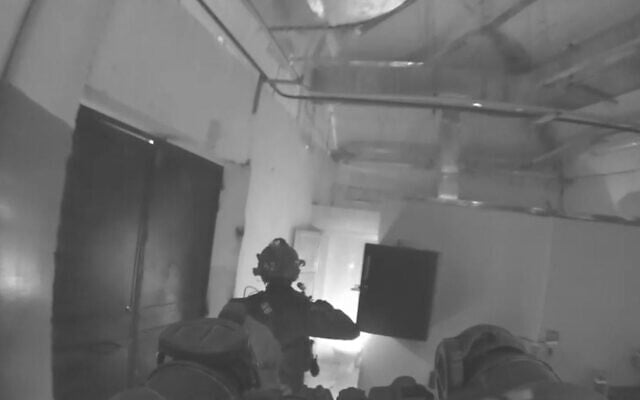 Members of the IAF’s Shaldag unit carry out a raid against an Iranian missile factory near Masyaf, Syria, September 8, 2024. (Israel Defense Forces)
Members of the IAF’s Shaldag unit carry out a raid against an Iranian missile factory near Masyaf, Syria, September 8, 2024. (Israel Defense Forces)The aboveground manufacturing site had been used to supply Hezbollah with many of the projectiles it would eventually launch at Israel when it started firing at northern Israel on October 8, 2023, a day after the Hamas invasion in the south.
The destruction of that site, as well as other IDF strikes in Syria targeting weapon shipments to Hezbollah, led Iran to rethink its strategy, according to the military, and to establish a new underground facility that would be safe from Israeli strikes.
The site that Iran constructed was 70-130 meters (230-430 foot) underground and thus virtually impossible to destroy from the air.
Iranian digging into the mountain at the research center began in late 2017. The IDF said it had intelligence on the facility from the moment construction began.
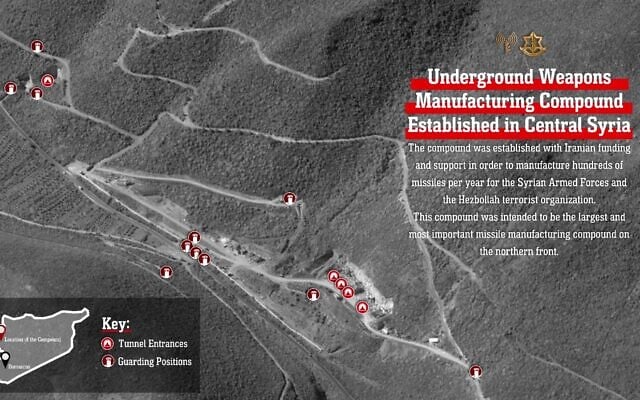 This infographic issued by the IDF on January 2, 2025, shows where an underground Iranian missile factory was built near Masyaf, Syria. (Israel Defense Forces)
This infographic issued by the IDF on January 2, 2025, shows where an underground Iranian missile factory was built near Masyaf, Syria. (Israel Defense Forces)By 2021, Iran had completed the digging and construction work and began bringing in equipment for mass-producing missiles. Over the following years, equipment continued to be delivered, and tests were carried out on the production line.
The facility was built in the shape of a horseshoe, with one entrance on the side of the mountain for raw materials and an exit nearby for the completed missiles. A third entrance adjacent to those two was used for logistics and to reach offices inside the facility. The office section also connected to the manufacturing section inside.
Along the horseshoe were at least 16 rooms housing the production line for the missiles, from planetary mixers for the rocket fuel to missile body construction and paint rooms.
The facility was not yet completely active when Israel launched its operation against it, but according to the military, it was at the final stages of being declared operational by Iran. At least two missiles had been successfully manufactured as part of testing, and rocket engines were already being mass produced.
Elite Air Force unit breached underground facility 200 kilometers from Israel, laid explosives and escaped unscathed after 2.5 hours, in one of the most complex operations to date
The Israeli Air Force on Thursday revealed details and footage from one of its most daring and complex commando operations ever, in which 120 members of special forces units raided and destroyed an underground Iranian missile manufacturing plant deep in Syria in September.
At the time, the regime of Bashar al-Assad was still in power in Syria, and Israel had not yet launched its devastating campaign against Hezbollah in Lebanon.
Some of the details of the September 8 operation previously reported by foreign media outlets — including the name of the raid — are now known to have been wrong, or slightly incorrect.
The raid — dubbed internally by the Israel Defense Forces “Operation Many Ways” — was aimed at destroying an underground facility used by Iranian forces to manufacture precision missiles for Hezbollah in Lebanon and for the Assad regime in Syria.
The facility, codenamed by the military “Deep Layer,” was dug into a mountain at the Scientific Studies and Research Center, known as CERS or SSRC, in the Masyaf area of Syria, west of Hama. The site lies more than 200 kilometers (124 miles) north of the Israeli border, and some 45 kilometers (28 miles) from Syria’s western coastline.
The IDF said the site was Iran’s “flagship project” in its effort to arm Hezbollah.
The revelation of the raid comes weeks after the fall of the Assad regime, which was closely aligned with Iran. Assad allowed Iran to use Syria to manufacture and deliver weapons to Hezbollah. Iranian forces have since withdrawn from Syria after losing their close ally.
The Iranian facility
Iran began planning “Deep Layer” in 2017, after an Israeli airstrike that same year at CERS took out a rocket engine manufacturing site that was stationed aboveground, according to the military.

The aboveground manufacturing site had been used to supply Hezbollah with many of the projectiles it would eventually launch at Israel when it started firing at northern Israel on October 8, 2023, a day after the Hamas invasion in the south.
The destruction of that site, as well as other IDF strikes in Syria targeting weapon shipments to Hezbollah, led Iran to rethink its strategy, according to the military, and to establish a new underground facility that would be safe from Israeli strikes.
The site that Iran constructed was 70-130 meters (230-430 foot) underground and thus virtually impossible to destroy from the air.
Iranian digging into the mountain at the research center began in late 2017. The IDF said it had intelligence on the facility from the moment construction began.

By 2021, Iran had completed the digging and construction work and began bringing in equipment for mass-producing missiles. Over the following years, equipment continued to be delivered, and tests were carried out on the production line.
The facility was built in the shape of a horseshoe, with one entrance on the side of the mountain for raw materials and an exit nearby for the completed missiles. A third entrance adjacent to those two was used for logistics and to reach offices inside the facility. The office section also connected to the manufacturing section inside.
Along the horseshoe were at least 16 rooms housing the production line for the missiles, from planetary mixers for the rocket fuel to missile body construction and paint rooms.
The facility was not yet completely active when Israel launched its operation against it, but according to the military, it was at the final stages of being declared operational by Iran. At least two missiles had been successfully manufactured as part of testing, and rocket engines were already being mass produced.
The IDF has assessed that the facility would have been used to produce between 100 and 300 missiles a year, including long-range missiles with ranges of up to 300 kilometers, precision-guided missiles with ranges of up to 130 kilometers, and short-range rockets with ranges of 40-70 kilometers.
According to the IDF’s assessments, the facility, located relatively close to the border with Lebanon, was meant to replace Iran’s method of trucking missiles and parts from its own territory to Lebanon via Syria. Such convoys were repeatedly struck by the IAF over the years. The distance the weapons would need to travel from the new facility to reach Hezbollah would be far shorter.
The IDF has assessed that the facility would have been used to produce between 100 and 300 missiles a year, including long-range missiles with ranges of up to 300 kilometers, precision-guided missiles with ranges of up to 130 kilometers, and short-range rockets with ranges of 40-70 kilometers.
According to the IDF’s assessments, the facility, located relatively close to the border with Lebanon, was meant to replace Iran’s method of trucking missiles and parts from its own territory to Lebanon via Syria. Such convoys were repeatedly struck by the IAF over the years. The distance the weapons would need to travel from the new facility to reach Hezbollah would be far shorter.
Preparations to strike
The general idea of raiding and destroying the facility began to take form years ago, but only when the current multifront war began did top officials begin to consider it as a serious possibility.
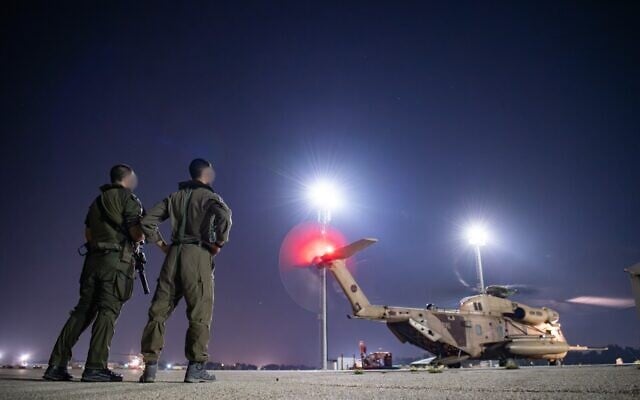 Members of the IAF’s Shaldag unit prepare to carry out a raid against an Iranian missile factory in Syria, September 8, 2024. (Israel Defense Forces)
Members of the IAF’s Shaldag unit prepare to carry out a raid against an Iranian missile factory in Syria, September 8, 2024. (Israel Defense Forces)The IAF’s Shaldag was chosen for the role because of its capabilities and training, and because the IAF thought it would be more efficient to carry out the raid using its own special forces rather than a commando unit from the Ground Forces or the Navy.
Two months before the raid was carried out, Shaldag and Unit 669 members were already training for the operation by drilling various models and scenarios, to ensure that if anything did not go to plan there would always be a backup.
Training was held concurrently with the campaign against Hamas in Gaza and while the IAF was conducting strikes in Lebanon and defending against daily barrages of rockets and drones by Hezbollah and other Iran-backed militias.
The training itself was considered by the IAF to be something of a high risk, as it took up a lot of attention and resources amid the war and, if the raid had not been carried out, it would have been a waste of time.
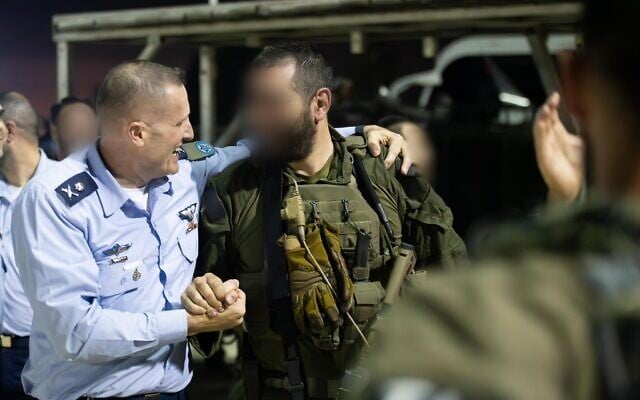 IAF chief Maj. Gen. Tomer Bar (left) is seen with the commander of the Shaldag unit, Lt. Col. ‘Bet’ following a raid against an Iranian missile factory in Syria, September 8, 2024. (Israel Defense Forces)
IAF chief Maj. Gen. Tomer Bar (left) is seen with the commander of the Shaldag unit, Lt. Col. ‘Bet’ following a raid against an Iranian missile factory in Syria, September 8, 2024. (Israel Defense Forces)Intelligence efforts were ramped up ahead of the operation in order to plan where exactly the soldiers would land, how they would enter and destroy the facility, what the layout of the site looked like and what sort of threats they could face — including Syrian air defense systems and ground forces.
Lastly, the timing of the operation needed to be determined. September 8 was chosen due to a myriad of reasons, among them the clear weather conditions for IAF helicopters carrying the troops.
The general idea of raiding and destroying the facility began to take form years ago, but only when the current multifront war began did top officials begin to consider it as a serious possibility.

The IAF’s Shaldag was chosen for the role because of its capabilities and training, and because the IAF thought it would be more efficient to carry out the raid using its own special forces rather than a commando unit from the Ground Forces or the Navy.
Two months before the raid was carried out, Shaldag and Unit 669 members were already training for the operation by drilling various models and scenarios, to ensure that if anything did not go to plan there would always be a backup.
Training was held concurrently with the campaign against Hamas in Gaza and while the IAF was conducting strikes in Lebanon and defending against daily barrages of rockets and drones by Hezbollah and other Iran-backed militias.
The training itself was considered by the IAF to be something of a high risk, as it took up a lot of attention and resources amid the war and, if the raid had not been carried out, it would have been a waste of time.

Intelligence efforts were ramped up ahead of the operation in order to plan where exactly the soldiers would land, how they would enter and destroy the facility, what the layout of the site looked like and what sort of threats they could face — including Syrian air defense systems and ground forces.
Lastly, the timing of the operation needed to be determined. September 8 was chosen due to a myriad of reasons, among them the clear weather conditions for IAF helicopters carrying the troops.
A timeline of the raid
In the evening of September 8, 100 members of Shaldag and another 20 members of Unit 669 boarded four CH-53 “Yasur” heavy transport helicopters and set off from an airbase in Israel for Syria.
Joining them were another two attack helicopters to provide close air support, 21 fighter jets, five drones and 14 spy planes and other aircraft. Another 30 aircraft waited in Israel on standby in case something did not go to plan.
The six helicopters flew over the Mediterranean Sea far off the coast of Lebanon, before crossing into Syria above its own coastline. The choppers flew unusually low in order to evade Syrian radars and air defense systems.
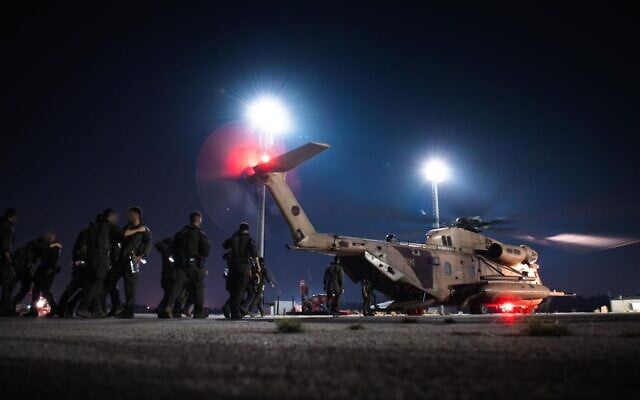 Members of the IAF’s Shaldag unit prepare to carry out a raid against an Iranian missile factory in Syria, September 8, 2024. (Israel Defense Forces)
Members of the IAF’s Shaldag unit prepare to carry out a raid against an Iranian missile factory in Syria, September 8, 2024. (Israel Defense Forces)At the time, the Masyaf area had the second-highest concentration of air defenses in Syria, surpassed only by Damascus, according to the IDF, with dozens of radars and defense systems that could detect and engage Israeli aircraft. Some of those radars had been destroyed in previous IAF strikes in Syria, and had not been repaired by September 8.
Adding to the complexity of the raid, Russian forces maintained a substantial military presence on the Syrian coast, with their own air defense systems.
It took just 18 minutes for the helicopters to fly from the coast to the facility, during which the aircraft were not detected. At the same time, IAF fighter jets and drones along with Navy missile boats launched a major wave of strikes targeting both the CERS facility and several other sites in Syria. The strikes were intended to both mask the approach of the helicopters and trick the Syrian military into believing this was a regular Israeli attack, hundreds of which had been carried out over the years, including at Masyaf.
Some of the strikes that night were aimed at luring Syrian soldiers away from CERS, though dozens were identified beginning to approach the facility as the raid began. Strikes were also carried out against the roads and anyone trying to reach the site.
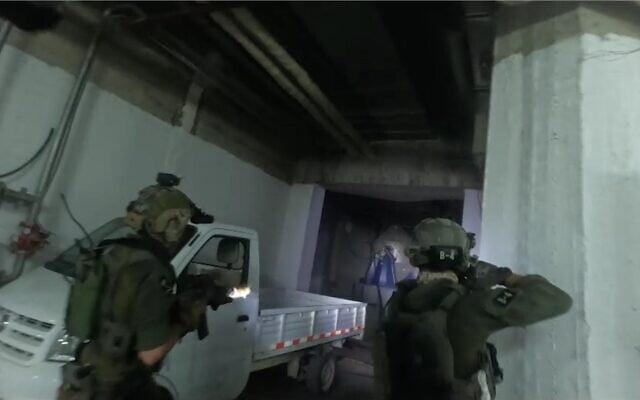 Members of the IAF’s Shaldag unit carry out a raid against an Iranian missile factory near Masyaf, Syria, September 8, 2024. (Israel Defense Forces)
Members of the IAF’s Shaldag unit carry out a raid against an Iranian missile factory near Masyaf, Syria, September 8, 2024. (Israel Defense Forces)The first of the CH-53 “Yasur” helicopters landed close to the entrance, dropping off several Shaldag commandos, while another two choppers simultaneously landed at another position in the area overlooking the science center. The fourth helicopter waited behind for several minutes before landing where the first one had, dropping off additional troops.
The four helicopters then flew away to other positions in the area, where they landed and waited for over two hours for the 100 commandos to carry out their mission.
The 20 Unit 669 members, still on board the choppers, were to spring into action if any of the commandos were wounded. The plan was to treat any wounded soldiers, but not to leave until the end of the mission. Therefore, Unit 669 brought along additional medical equipment to act as a makeshift hospital in the event of an injury.
At the facility, a first team of commandos began to secure the area while a second team advanced toward the entrance, killing two guards. Another team set up on a nearby hill, from which they flew a small drone to observe the raid and eliminate anyone approaching the facility.
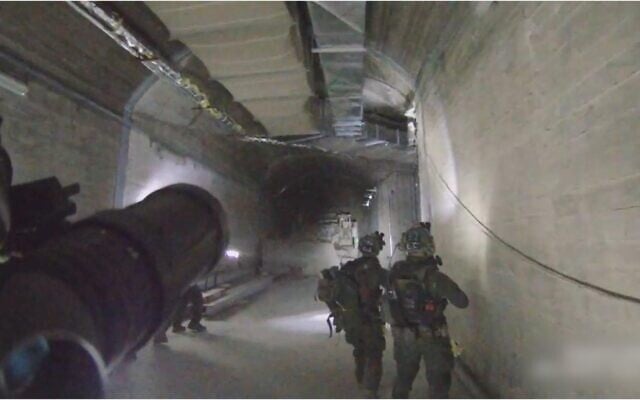 Members of the IAF’s Shaldag unit carry out a raid against an Iranian missile factory near Masyaf, Syria, September 8, 2024. (Israel Defense Forces)
Members of the IAF’s Shaldag unit carry out a raid against an Iranian missile factory near Masyaf, Syria, September 8, 2024. (Israel Defense Forces)At nighttime, Syrian soldiers would lock the three entrances to the facility and guard the perimeter. The IDF said there were fewer guards at the site than would have likely been had the facility already been active, and no one was inside when the raid was carried out.
One of the central challenges of the mission was getting through the heavy duty doors at the entrance to the underground site. According to officers who participated in the planning and the mission itself, this was no easy task.
At the mission’s 50-minute mark, the first team of commandos managed to break through one of the entrances — the one used for logistics and to reach the offices. The soldiers entered the site and reached the two production entrances — the horseshoe — opening them using forklifts that were inside the facility. The IDF had known in advance that the facility had such equipment, and had sent some of the commandos participating in the raid to get forklift certification.
At the same time, another team of commandos carrying explosives arrived at the entrances. The troops had brought a quad bike with them in one of the choppers to enable them to quickly move to and through the facility to plant the explosives.
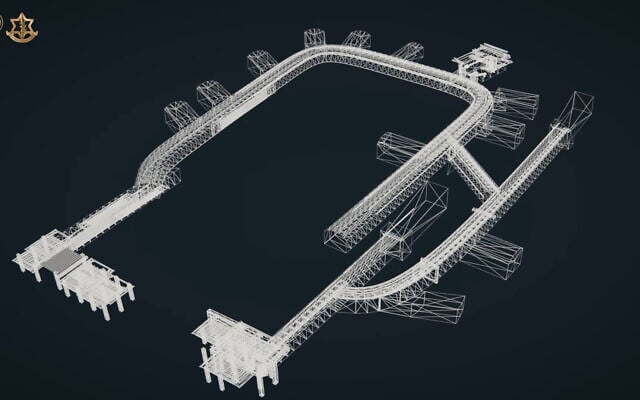 This illustrative map shows an underground Iranian missile facility near Masyaf, Syria, raided by the IAF’s Shaldag unit on Sepetmeber 8, 2024. (Israel Defense Forces)
This illustrative map shows an underground Iranian missile facility near Masyaf, Syria, raided by the IAF’s Shaldag unit on Sepetmeber 8, 2024. (Israel Defense Forces)Some 50 commandos then moved along the facility’s production line, attaching bombs to all of the equipment, and especially the three planetary mixers. The other 50 waited outside and continued to keep the area clear by scanning the area and firing at threats.
At the same time, fighter jets continued to pound the surrounding region to prevent dozens of people identified on the ground — apparently Syrian soldiers — from approaching. In all, 49 munitions were used by IAF aircraft during the raid.
After the commandos had rigged up all the explosives — around 300 kilograms’ (660 pounds’) worth — to a remote detonator planted at the entrance to the site, all 100 evacuated to the initial landing site. The helicopters flew in from their waiting positions, picking up the soldiers after two and a half hours on the ground.
As they boarded, Shaldag’s chief explosives specialist set off the bombs — a blast with an estimated as the equivalent of one ton of explosives, when factoring in the explosive material inside the facility.
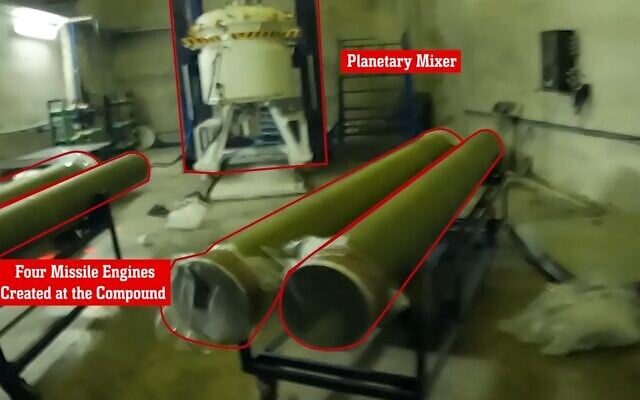 Inside an Iranian missile factory in Syria, during a raid by the IAF’s Shaldag unit, September 8, 2024. (Israel Defense Forces)
Inside an Iranian missile factory in Syria, during a raid by the IAF’s Shaldag unit, September 8, 2024. (Israel Defense Forces)Soldiers who participated in the operation said the underground blast was not only visible but could be felt as well, like “a mini earthquake.”
The helicopters then flew away from the facility back toward the sea, and then to Israel. Some of their equipment, including the quad bike, was left behind.
Hundreds of Syrian soldiers reached CERS around an hour after the troops left, according to the military, highlighting time crunch for the operation.
The IDF assessed that it killed some 30 guards and Syrian soldiers during the entire operation. Syrian media at the time reported 14 dead and 43 wounded.
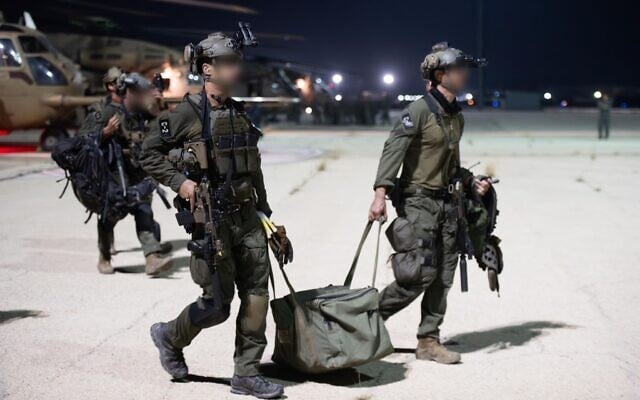 Members of the IAF’s Shaldag unit in Israel following a raid against an Iranian missile factory in Syria, September 8, 2024. (Israel Defense Forces)
Members of the IAF’s Shaldag unit in Israel following a raid against an Iranian missile factory in Syria, September 8, 2024. (Israel Defense Forces)The soldiers also captured some intelligence documents at the facility, which the military said proved its assessments that the site was near being operational.
Currently, the IDF said the underground site is not in use, and Iran has withdrawn from Syria following the fall of the Assad regime. link
- IDF says number of troop suicides has risen during war, with hundreds of thousands in reserves
The IDF says it has seen a rise in the number of suspected suicides in the military amid the war, as it releases statistics of its fatalities from the past two years.
According to the IDF’s data, 38 soldiers are believed to have taken their own lives in 2023 and 2024, including 28 since the October 7, 2023, onslaught that started the current war. In 2022, the IDF recorded 14 suicides and in 2021 it recorded 11.
Unsurprisingly due to ongoing war in the Gaza Strip and fighting in Lebanon and on other fronts, the number of deaths in the IDF in 2023 and 2024 have been the highest in decades.
According to the IDF, 558 soldiers were killed in 2023, including 512 during “operational activity” — apparently including the hundreds who were killed during Hamas’s October 7 onslaught — and three in terror attacks.
Sixteen soldiers died in accidents — two in training, four in civilian car crashes, five in military car crashes, one as a result of an accidental weapon discharge, and four in other incidents — and 10 died from illness in 2023.
In 2023, the IDF says that 17 soldiers were believed to have taken their own lives. They include seven conscripts, four career soldiers, and seven reservists. Seven of the suspected suicides in 2023 were after the October 7 onslaught.
In the past year, the total number of fatalities in the IDF has decreased compared to the previous year, but the number of suicides has risen, according to the IDF’s data.
In 2024, the IDF recorded a total of 363 deaths in the military, including 295 in operational activity amid the war and 11 in terror attacks.
Twenty-three soldiers died in accidents — 17 in civilian car crashes, three in civilian car crashes, and three in other incidents — and 13 died by illness in 2024.
In 2024, the IDF says at least 21 soldiers died by suspected suicide, including seven conscripts, two career soldiers, and 12 reservists.
The high number of reservist suicides is explained by the IDF calling up nearly 300,000 reservists during the war.
All of the 38 suspected suicides in 2023 and 2024 were male troops.
The IDF says it is working to prevent suicides in the military, including by opening a 24/7 helpline, which has received over 3,900 calls since it was established in October 2023. The IDF has also called up over 800 reservist mental health officers amid the war.
Since the beginning of the war, the IDF says 891 soldiers have died, not all of them in combat. They include 329 during the October 7 onslaught, at least 390 during fighting in Gaza, 37 in attacks on northern Israel, 50 during fighting inside Lebanon, and 11 in the West Bank.
In the evening of September 8, 100 members of Shaldag and another 20 members of Unit 669 boarded four CH-53 “Yasur” heavy transport helicopters and set off from an airbase in Israel for Syria.
Joining them were another two attack helicopters to provide close air support, 21 fighter jets, five drones and 14 spy planes and other aircraft. Another 30 aircraft waited in Israel on standby in case something did not go to plan.
The six helicopters flew over the Mediterranean Sea far off the coast of Lebanon, before crossing into Syria above its own coastline. The choppers flew unusually low in order to evade Syrian radars and air defense systems.

At the time, the Masyaf area had the second-highest concentration of air defenses in Syria, surpassed only by Damascus, according to the IDF, with dozens of radars and defense systems that could detect and engage Israeli aircraft. Some of those radars had been destroyed in previous IAF strikes in Syria, and had not been repaired by September 8.
Adding to the complexity of the raid, Russian forces maintained a substantial military presence on the Syrian coast, with their own air defense systems.
It took just 18 minutes for the helicopters to fly from the coast to the facility, during which the aircraft were not detected. At the same time, IAF fighter jets and drones along with Navy missile boats launched a major wave of strikes targeting both the CERS facility and several other sites in Syria. The strikes were intended to both mask the approach of the helicopters and trick the Syrian military into believing this was a regular Israeli attack, hundreds of which had been carried out over the years, including at Masyaf.
Some of the strikes that night were aimed at luring Syrian soldiers away from CERS, though dozens were identified beginning to approach the facility as the raid began. Strikes were also carried out against the roads and anyone trying to reach the site.

The first of the CH-53 “Yasur” helicopters landed close to the entrance, dropping off several Shaldag commandos, while another two choppers simultaneously landed at another position in the area overlooking the science center. The fourth helicopter waited behind for several minutes before landing where the first one had, dropping off additional troops.
The four helicopters then flew away to other positions in the area, where they landed and waited for over two hours for the 100 commandos to carry out their mission.
The 20 Unit 669 members, still on board the choppers, were to spring into action if any of the commandos were wounded. The plan was to treat any wounded soldiers, but not to leave until the end of the mission. Therefore, Unit 669 brought along additional medical equipment to act as a makeshift hospital in the event of an injury.
At the facility, a first team of commandos began to secure the area while a second team advanced toward the entrance, killing two guards. Another team set up on a nearby hill, from which they flew a small drone to observe the raid and eliminate anyone approaching the facility.

At nighttime, Syrian soldiers would lock the three entrances to the facility and guard the perimeter. The IDF said there were fewer guards at the site than would have likely been had the facility already been active, and no one was inside when the raid was carried out.
One of the central challenges of the mission was getting through the heavy duty doors at the entrance to the underground site. According to officers who participated in the planning and the mission itself, this was no easy task.
At the mission’s 50-minute mark, the first team of commandos managed to break through one of the entrances — the one used for logistics and to reach the offices. The soldiers entered the site and reached the two production entrances — the horseshoe — opening them using forklifts that were inside the facility. The IDF had known in advance that the facility had such equipment, and had sent some of the commandos participating in the raid to get forklift certification.
At the same time, another team of commandos carrying explosives arrived at the entrances. The troops had brought a quad bike with them in one of the choppers to enable them to quickly move to and through the facility to plant the explosives.

Some 50 commandos then moved along the facility’s production line, attaching bombs to all of the equipment, and especially the three planetary mixers. The other 50 waited outside and continued to keep the area clear by scanning the area and firing at threats.
At the same time, fighter jets continued to pound the surrounding region to prevent dozens of people identified on the ground — apparently Syrian soldiers — from approaching. In all, 49 munitions were used by IAF aircraft during the raid.
After the commandos had rigged up all the explosives — around 300 kilograms’ (660 pounds’) worth — to a remote detonator planted at the entrance to the site, all 100 evacuated to the initial landing site. The helicopters flew in from their waiting positions, picking up the soldiers after two and a half hours on the ground.
As they boarded, Shaldag’s chief explosives specialist set off the bombs — a blast with an estimated as the equivalent of one ton of explosives, when factoring in the explosive material inside the facility.

Soldiers who participated in the operation said the underground blast was not only visible but could be felt as well, like “a mini earthquake.”
The helicopters then flew away from the facility back toward the sea, and then to Israel. Some of their equipment, including the quad bike, was left behind.
Hundreds of Syrian soldiers reached CERS around an hour after the troops left, according to the military, highlighting time crunch for the operation.
The IDF assessed that it killed some 30 guards and Syrian soldiers during the entire operation. Syrian media at the time reported 14 dead and 43 wounded.

The soldiers also captured some intelligence documents at the facility, which the military said proved its assessments that the site was near being operational.
Currently, the IDF said the underground site is not in use, and Iran has withdrawn from Syria following the fall of the Assad regime. link
The IDF says it has seen a rise in the number of suspected suicides in the military amid the war, as it releases statistics of its fatalities from the past two years.
According to the IDF’s data, 38 soldiers are believed to have taken their own lives in 2023 and 2024, including 28 since the October 7, 2023, onslaught that started the current war. In 2022, the IDF recorded 14 suicides and in 2021 it recorded 11.
Unsurprisingly due to ongoing war in the Gaza Strip and fighting in Lebanon and on other fronts, the number of deaths in the IDF in 2023 and 2024 have been the highest in decades.
According to the IDF, 558 soldiers were killed in 2023, including 512 during “operational activity” — apparently including the hundreds who were killed during Hamas’s October 7 onslaught — and three in terror attacks.
Sixteen soldiers died in accidents — two in training, four in civilian car crashes, five in military car crashes, one as a result of an accidental weapon discharge, and four in other incidents — and 10 died from illness in 2023.
In 2023, the IDF says that 17 soldiers were believed to have taken their own lives. They include seven conscripts, four career soldiers, and seven reservists. Seven of the suspected suicides in 2023 were after the October 7 onslaught.
In the past year, the total number of fatalities in the IDF has decreased compared to the previous year, but the number of suicides has risen, according to the IDF’s data.
In 2024, the IDF recorded a total of 363 deaths in the military, including 295 in operational activity amid the war and 11 in terror attacks.
Twenty-three soldiers died in accidents — 17 in civilian car crashes, three in civilian car crashes, and three in other incidents — and 13 died by illness in 2024.
In 2024, the IDF says at least 21 soldiers died by suspected suicide, including seven conscripts, two career soldiers, and 12 reservists.
The high number of reservist suicides is explained by the IDF calling up nearly 300,000 reservists during the war.
All of the 38 suspected suicides in 2023 and 2024 were male troops.
The IDF says it is working to prevent suicides in the military, including by opening a 24/7 helpline, which has received over 3,900 calls since it was established in October 2023. The IDF has also called up over 800 reservist mental health officers amid the war.
Since the beginning of the war, the IDF says 891 soldiers have died, not all of them in combat. They include 329 during the October 7 onslaught, at least 390 during fighting in Gaza, 37 in attacks on northern Israel, 50 during fighting inside Lebanon, and 11 in the West Bank.
The Region and the World
-
Personal Stories
BROKEN DREAMS
Eitan LevyUriel Baruch (of blessed memory)Uriel planned to travel to the Seychelles Islands with his family. He envisioned a relaxing beach vacation, exploring the tropical forest on the islands, and feeding giant tortoises and colorful birds. In March 2024, his family was informed that he had been murdered.
Sahar Baruch z"l
Uriel planned to travel to the Seychelles Islands with his family. He envisioned a relaxing beach vacation, exploring the tropical forest on the islands, and feeding giant tortoises and colorful birds. In March 2024, his family was informed that he had been murdered.
Dark Legacy - The Abandonment of October 7th Hostages

A Legacy of Silence and VoidNimrod ShefferMajor-General (Reserves).
At times, one needs to describe reality in simple terms in order to believe that it is real. As I write these words, over 100 Israeli hostages abducted from their homes by Hamas with unspeakable violence on the morning of October 7, 2023, are living in the Hamas tunnels in Gaza. Some are no longer alive, but those who are have been living in crippling fear for nine months, imprisoned in solitary, locked up, fading away as the days go by, like photos in an old celluloid film.It is unbelievable, but over 100 Israeli citizens, human beings with families, dreams, fears, love, and emotions, are but a nuisance for the Prime Minister of Israel. Netanyahu tries to hide this from the public in order to stay in power and evade trial. But for Netanyahu (and his government), human life has no value. Israeli lives, their safety, and the unwritten covenant between them and the state all have no merit since the only thing that is of true importance to him is remaining in power.Over the months following the hostage deal of November 2023, Netanyahu has been consistently sabotaging any chance of bringing back the hostages who remain in Gaza. He does so by tying the hands of the negotiating team, by sending signals that make it clear to Hamas that he has no intention of paying the price of a deal, and by relaying messages via the foreign press (and, at times, the Israeli press) of the same.This will be his legacy.A legacy of cynicism and inconceivable cruelty, of evil and imperviousness. A legacy of severing the State of Israel from its values, primarily those of brotherhood and solidarity. His legacy will forever be abandonment and political, military, and human blindness. A legacy of continuous failure, destruction of state institutions, and preference for the self over everything else, including the people and the state he headed. Yes, headed—in the past tense because the end is just around the corner, the end of an evil and cynical government, the aim of which is to dismember Israel and reassemble it as a servant of the ruler.Thus, Bibi, we will not remember you, and we will not mention your name. We will silently mourn our dead, we will silently embrace those who return, we will silently fix and mend the pieces you broke in us, without a word about you. You are doomed to disappear from our lives, to dissipate as though you never were. That will be your legacy: silence. Null and void.Then, after all the evil, after all the pain and the fear, our people will rise from the dust and build what you failed to eradicate, the exemplary state of the Jewish people and this country’s citizens. And that, Bibi, will be our legacy, and you will have no part in it, not in a word, not in a letter, not in a gesture, and not in a note. Nothingness. A void.

Acronyms and Glossary
ICC - International Criminal Court in the Hague
IJC - International Court of Justice in the Hague
MDA - Magen David Adom - Israel Ambulance Corp
PA - Palestinian Authority - President Mahmud Abbas, aka Abu Mazen
PMO- Prime Minister's Office
UAV - Unmanned Aerial vehicle, Drone. Could be used for surveillance and reconnaissance, or be weaponized with missiles or contain explosives for 'suicide' explosion mission
Join my Whatsapp update group https://chat.whatsapp.com/IQ3OtwE6ydxBeBAxWNziB0
Twitter - @LonnyB58 Bluesky - @lonny-b.bsky.social
Twitter - @LonnyB58


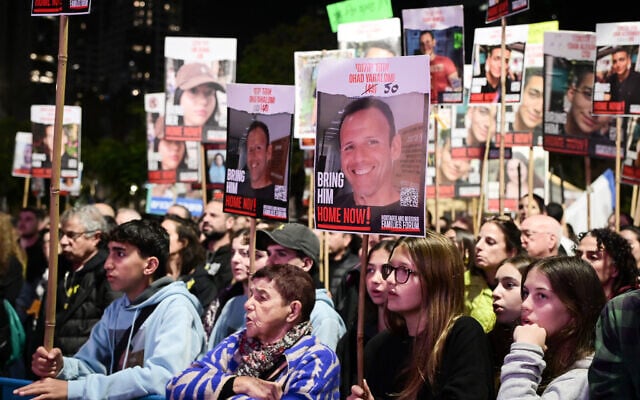
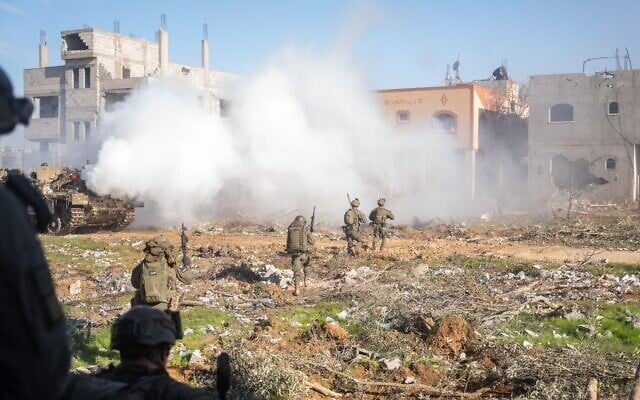
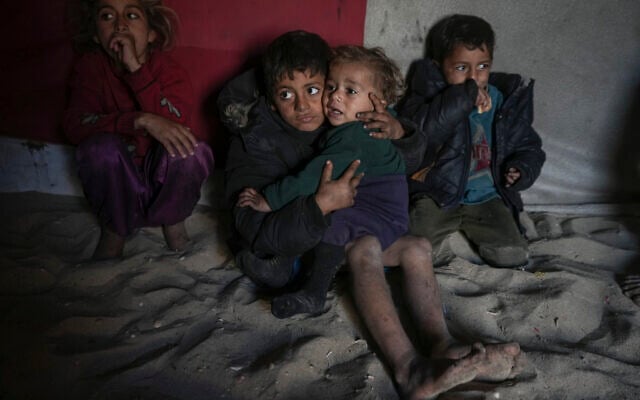
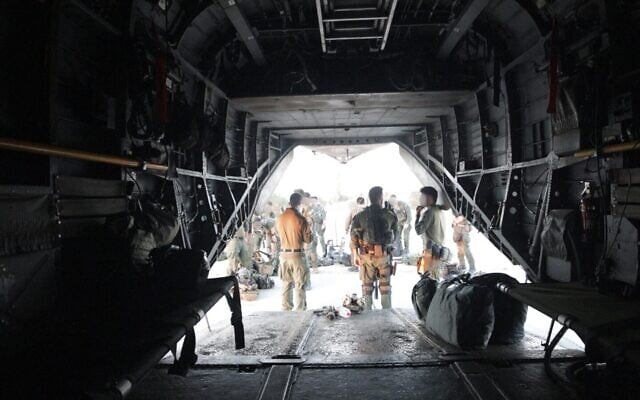





Comments
Post a Comment